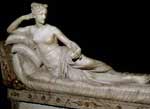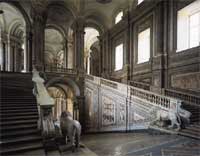Neoclassical art can find its origins in the ideas of the age of Enlightenment and was inspired by the classical age. In the middle of the XVIII century the excavations which uncovered entire cities like Pompeii and Herculaneum renewed the interest of artists in Greek and Roman artifacts. Rome became the centre of culture par excellence. The highest theoretician of Neoclassicism was Johan Joachin Winckelmann, who began a detailed study of classical antiquities. His great masterpiece “The History of Ancient Art” was published in December 1763. It analysed the classical world from a chronological and aesthetic point of view. For Winckelmann true art was Greek art and “the only way for us to become great, yes, inimitable, if it is possible, is the imitation of the Greeks”. Imitating, for neoclassical artists, meant looking at the past for inspiration and copying past aesthetic models to represent the ideals of the time and scenes from the present world. The relationship with the past was not a relationship of spiritual syntony (as it had been for Renaissance artists, who were also inspired by the classical world). Neoclassicism is mainly a reaction to the excesses of the baroque age (which was refused by the new vision of the world). Religion, as proposed by the principles of the age of Enlightenment, was also rejected. Specifically, religion had lost the central role it had played for centuries in society. The effects of this were unavoidably felt in art which took on a different meaning - a more general and public one. Artists refused the restrictions imposed by commissioning parties and chose the subjects they wished to represent freely. Religious scenes disappeared almost completely and mythological subjects were replaced by historical events or events where the middle classes were important. Paintings are highly realistic, almost photographic, thanks to cold colours, harsh outlines and a poor interest in the effects of light. Paintings in general are sober and keep the observer at a distance instead of involving him/her.
 Neoclassical principles are clearly evident in the sculpture of this period. Greek statues were studiedin detail although knowledge was fragmented and generally relied on Roman copies of Greek statues. Neoclassical sculpture has often been considered cold and impersonal. However, these features were the result of a precise choice of most major artists of the time, who aimed at teaching. Great importance was given to the preparation of works of sculpture, especially to the sketches which every artist drew before starting on the work itself. They were important because they represented the personality of the artist. The most important neoclassical artist in Italy was Antonio Canova.
Neoclassical principles are clearly evident in the sculpture of this period. Greek statues were studiedin detail although knowledge was fragmented and generally relied on Roman copies of Greek statues. Neoclassical sculpture has often been considered cold and impersonal. However, these features were the result of a precise choice of most major artists of the time, who aimed at teaching. Great importance was given to the preparation of works of sculpture, especially to the sketches which every artist drew before starting on the work itself. They were important because they represented the personality of the artist. The most important neoclassical artist in Italy was Antonio Canova.
 Neoclassicism principles are particularly obvious in architecture. The classical repertoire is applied to halls and churches (built as pagan temples),to theatres, barracks, hospitals and many other buildings with civil functions. Cities, the heart of civic life, became the main subject. Architects worked on urban planning, creating streets, squares, gardens. The modern concept of town planning dates to this period.
Neoclassicism principles are particularly obvious in architecture. The classical repertoire is applied to halls and churches (built as pagan temples),to theatres, barracks, hospitals and many other buildings with civil functions. Cities, the heart of civic life, became the main subject. Architects worked on urban planning, creating streets, squares, gardens. The modern concept of town planning dates to this period.